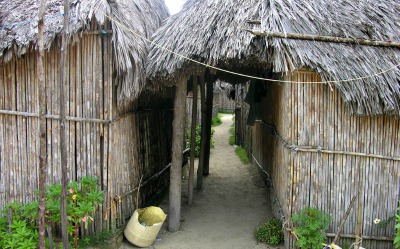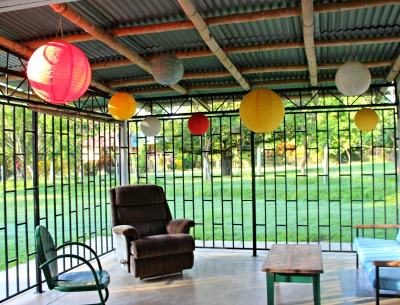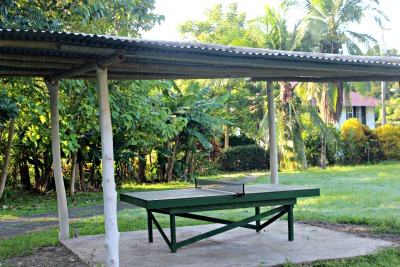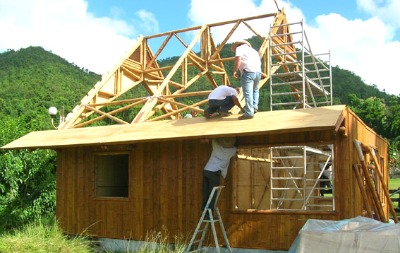
Before moving to Panama, I was already quite familiar with bamboo from my travels in Southeast Asia and while building houses in Japan.
In both Hong Kong and mainland China, I have seen bamboo scaffolding rising up 15, even 20 stories. In Indonesia, I've seen bamboo used for construction of airy pole buildings.
My only real bamboo construction experience has been with Tonkin cane from Vietnam. I still have some Tonkin cane stored along the side of my home in Seattle. It is left over from a fence I built 18 years ago.
Tonkin cane is solid, with literally no hollow core.
The bamboo has been stored outdoors in Seattle’s moist and mild climate for 18 years. It appears to have aged hardly at all. The fence that I built from this bamboo is in nearly the same good condition. Though it has been exposed to sun, rain, high and low temperatures for nearly two decades, I have only replaced a couple of canes in all those years.

We get plenty of rain and abundant sunshine here in Panama. It is an ideal combination for bamboo habitat. In fact, some of Panama's timber species grow 20 or 30 feet annually and can reach up to 8” in diameter.
In our town of Puerto Armuelles Panama, you can typically get timber bamboo 60 feet tall and 3”-5” in diameter (see photo).
The price is wonderfully affordable. A 60’ length of timber bamboo only costs ~$1.50. Unfortunately, you wouldn't want to use it to build your home.
This is because Panama's timber bamboo has a mostly hollow structure. Which mean it does not last long when used as the exterior of structures.
Most bamboo that I have encountered in Puerto Armuelles, and generally in Panama, appears to be some strain of fast-growing golden bamboo.
Panama's most common bamboos are prone to dry out and crack in the dry season. It also degrades rapidly when exposed to sunlight and is prone to mold and rot.

As these 2 photos show, the bamboo typically used to build homes in Panama is what is easily grown and harvested here. A fast-growing golden bamboo.
It is not the type of bamboo that North Americans think of as appropriate for construction. That is because it is not. These are not permanent structures. These homeowners know they will need to replace the bamboo in these small houses every few years.

However, sometimes a temporary building structure is just want you need.
We often use timber bamboo as temporary bracing or temporary fencing on our projects. I have made a couple of temporary sheds and a carport with it on our own property or in situations where I am “checking out” a design idea.
Since each 60’ length of timber bamboo costs about $1.50, it is a great, low cost, temporary building material. If it is protected from the sun and rain, the bamboo appears to last several years.

As you can see in the living room photo, we even use it in our own home. The bamboo you see in the photo is about 8 years old. We have replaced the bamboo on top of the zinc roof once in those 8 years. (Note: This open-air living room was added during the remodel, the rest of the house is 2 stories.)
I have seen photos online of beautiful bamboo structures in Costa Rica and other tropical countries.
In fact, I met a German man who has built a Bamboo house just over the border, on the beach in Costa Rica. I have yet to visit his project and find out more about it. I do know that he brought in a builder from a high-end area of Costa Rica who specializes in bamboo construction for expats. It is still on my “to do” list to visit his home and find out what strain of bamboo he used.

There are roughly 1500 known bamboo species on the planet. However, only a hand-full of them can be used for construction.
In Latin America, including Panama, the yellow striped bamboo, Bambusa vulgaris 'Vittata', is everywhere. Sadly, due to its hollow core, it cannot be used for construction.
The best construction-worthy bamboo grown in Latin America is the Guadua Angustifolia. Unfortunately, it is not a popular crop. Teak is much more popular.
People have been growing teak as an income-crop for many years. Until that changes, there likely won't be a much high-quality Guadua Bamboo available in Panama. Because there isn't much of this bamboo for sale, it will cost you more than you probably want to pay.
However, there seems to be sufficient Guadua Bamboo available in nearby Costa Rica (see Rudy's comment in the comment section).
Until it is more widely available in Panama, that may be a good option. You would have to investigate any import taxes you might have to pay to bring the bamboo over the border into Panama.
Of course, you can import the construction grade bamboo you need from various sources.
At least one of the sources I used to write this post (see below), offers to deliver construction grade bamboo to your building site in Panama. My guess is that cost of importing bamboo, relative to other construction materials, will be expensive. But it does seem worth checking out the cost.
The good thing is if more people want to build with Bamboo, more people will produce it, hopefully in Panama. This increase in supply will decrease the cost of bamboo.
Hopefully, building high-quality bamboo construction in Panama will stop being a luxury construction method.
With a greater supply of construction grade bamboo in Panama, bamboo can become an excellent way to build an attractive and affordable eco-friendly house.